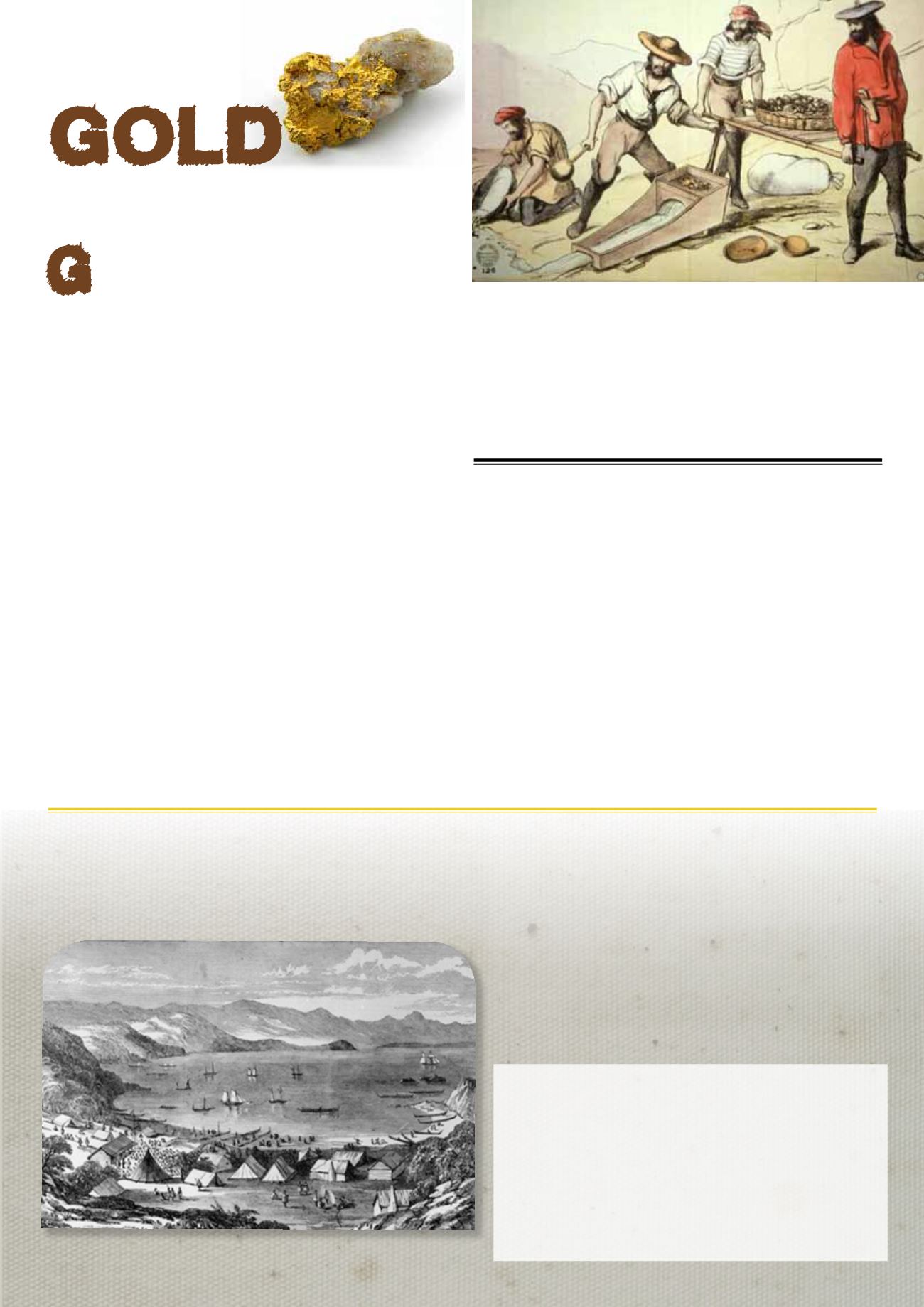

EARLY
GOLD
G
old mining in the Coromandel began in earnest – after some fits
and starts - in 1852 when the Auckland Provincial Council offered
a £500 reward for a ‘payable’ gold find on the north island.
Enter one Charles Ring (born 1816) who came to Auckland via Australia
where he had opened a store which sadly burned (one of many business
disasters he survived). He then tried his luck in Auckland, where he
managed to informally purchase a few farms for raising sheep from
a local Maori chief. With his brother Frederick, they imported several
hundred head of cattle, but that venture did not work out as they could
then buy no pasture land for the herd.
In 1849, news came of the California gold rush, and they sold the cattle
at a loss and sailed off to seek their fortunes. After a successful stint of
prospecting, Charles bought goods for opening another store, but he lost
that stock in a shipwreck.
He and Frederick booked passage back to Australia, but ill fate visited
once again. Their ship tangled with a reef off Fiji. The shipwrecked
passengers (many fellow prospectors) survived, trying then to complete
the voyage in an open boat with little provisions. Luckily, an American
whaler caught sight of the stranded crew, rescued them all and
transported them back to familiar territory, Auckland.
THE RINGS GET A FOOTHOLD IN THE COROMANDEL
The Rings managed to secure land northeast of Coromandel town,
and opened a kauri sawmill on Kapanga Stream. By this time the
Coromandel’s kauri timber operations had already been in overdrive for
decades from the many visiting timber-harvesting ships (such as 1820
arrival of the HMS
Coromandel
), and European settlers from the 1830s.
Many local Maori were already working for the newcomers – growing
potatoes and peaches for them, or trading fish and game.
Because of their experience in the California gold fields, the Ring
brothers took notice of the area’s geology and realized it had gold
potential, not just in their stream, but through the promising quartz veins
found through most of the Coromandel territory.
Prospecting expeditions through Maori land were undertaken. Some
Maori tribes were welcoming and gracious, but others attacked the
gold seekers. Escorted by a European settler who had experience
with the natives (and presumably because of the brothers’ legendary
graciousness), they managed to traverse a lot of territory ‘just looking’
for signs of quartz veins and gold in the alluvial streambeds. Charles
became especially proficient as a Maori linguist.
In 1852, Auckland Provincial Council offered a £500 reward for a
‘payable’ gold find, and Charles Ring was ready with samples from their
Kapanga Stream area which was fed by Driving Creek. The origins of this
name came from the practice of using a header or ‘driving’ dam to store
felled timber. When the dam was released, the kauri logs travelled down
the ‘driving’ creek to McGregor Bay at Coromandel Town.
The council members dutifully trekked three miles upstream to the Ring
brothers’ mill, and their find looked promising. However, because of the
complexity of the Maori land ownership, not much of their reported finds
were actually workable yet, thus they were paid only £200 reward money.
The government did settle mining licensing fees with the Maori for the
‘Crown’s Kapanga block’, and it was not long before the area was
Early gold mining meant hard work. The simplest method was panning the stream’s
gravel bed for flakes of gold. Easy pickings for first-comers. Next was the use of a
sluice box, where gravel and sand were shoveled into the top grate where the smaller
bits would be washed over the lower trough. The heavier gravel and gold flakes would
lodge against stick barriers called ‘riffles’. In the longer sluice trays, gravel was shoved
right into the trough and larger rocks removed by hand.
Note the man rocking the sluice box is using a simple water scoop. An improvement
was to instead direct stream water through a pipe or wooden channel, and to use the
longer trays. The pan came out later to swirl away the lighter sand, leaving just the gold
flakes. Often men would merge their claims and work as a team, as is seen here.
MEETING WITH THE
MAORI FOR THE 1852
GOLD FIELD AGREEMENT
Within one month of the land use agreement, over 3,000 men arrived on the
Coromandel field to mine for gold, but the rush lasted just a few months.
L
and use agreements for logging, gold mining, and
pastureland between the Crown and Maori tribes were
made in stages over decades. Some individuals, were also able
to secure rights for land use or for outright purchase.
The Ring’s Driving Creek discovery cash reward was not fully
honoured because there was not (yet) Maori agreement for
permission to mine in vast areas.
However, in October of 1852, Lieutenant-Governor Wynyard
met with Maori chiefs at Coromandel Harbour, and Heaphy
illustrated the variety of Maori longboats and European ships
assembled.
Showing NZ’s early history depends on artist’s sketches and
watercolours, in this case those of artist/surveyor Charles
Heaphy.
(continued on page 15)
Details of Hauraki Peninsula land use agreement
of
November 30, 1852 between
the Crown and Maori landowners.
Area: Between Cape Coleville and Kauaeranga
(Shortland, Thames).
“Under this agreement, the Government pledges itself to pay
per anum to the Maoris: For less than 500 men digging £600,
for 1000 to 1500 men digging £1500, for 1,500 to 2,000 men
digging £1500: and in addition, 2s for each miner’s license
issued. To meet this and other expenses, a tax of £1 10 s per
month per man was imposed on the miners.”
WWW.COROMANDELLIFE.CO.NZ13
The Ring brothers and the
discovery of Driving Creek’s gold

















